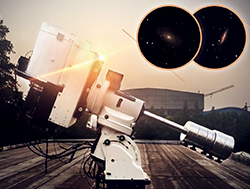Andor iKon-XL VLA utilized in planetary transit surveys in Antarctica

Photo by Andor Technology plc.
The recent discovery of a trio of Earth-like exoplanets just 39 light years away only reinforces the need for more sensitive detection systems to survey the sky. The launch of the Andor iKon-XL Very Large Area (VLA) Astronomy CCD platform and its successful placement on a new planetary transit survey telescope on the Antarctic Plateau raises the prospect of more breakthroughs to come.
The iKon-XL VLA is purpose-designed to suit the long-exposure, remote operation needs of astrophysical surveys that have, until now, been heavily reliant on more conventional cooled CCD technologies. Patent-pending ColdSpace™ technology is capable of thermoelectrically cooling very large 16.8 Megapixel back-illuminated sensors to -100°C, avoiding the need for liquid nitrogen or unreliable cryo coolers, while the large pixels bring maximum photon capture. The result is industry-leading low noise performance and exceptional extended dynamic range that is complemented by up to 18-bit digitisation and up to 95% QE performance from UV to NIR.
All of these technological advances are integrated within the robust, low maintenance, design making it ideal for many experimental set-ups, including in remote astronomical observing sites. This was especially important for the new Bright Star Survey Telescope (BSST) in Antarctica, where the continuous darkness and large clear-sky fraction in the winter months greatly enhance the detection efficiency but the equipment has to survive more extreme temperature conditions.
The BSST with its iKon-XL camera has now completed test observations, during which the optical design and temperature alignment tolerances were verified. During these trials, the BSST also successfully observed transiting events of two exoplanets, called HAT-P-3b and HAT-P-12b. Dr. Zhengyang Li, from the Nanjing Institute of Astronomical Optics and Technology, China, says “the optical design and tolerance analysis guarantee the quality of BSST. The test observations reveal exceptionally clear single star images with a photometric precision of 3.5 mmag achieved for magnitude 11 stars with just 75s exposures.”
According to Andor’s Colin Coates, “Antarctica is a hugely promising site for planetary transit surveys, However, the extreme environment and remote location brings additional technical challenges that must be overcome. Our low maintenance TE cooling technology and custom-designed low temperature shutter housing performed faultlessly and is essential to the success of the BSST.
Our range of CCD and EMCCD cameras have been widely employed at a high proportion of the current crop of terrestrial telescopes. Now, with the addition of the Andor iKon-XL Very Large Area Astronomy CCD platform we are set to build on that dominant position.”
For more information, please visit http://www.andor.com.
News Categories
- » NEWS HOME
- » Automation & Robotics
- » Industry 4.0
- » Material Handling
- » Sensors
- » Quality & Testing
- » Machine Vision
- » Laser & Optics
- » Metalworking
- » Motion Control & Drives
- » Hydraulics & Pneumatics
- » Process Industry
- » Renewable Energy
- » Agriculture
- » Home & Office Furniture
- » Environmental Tech

